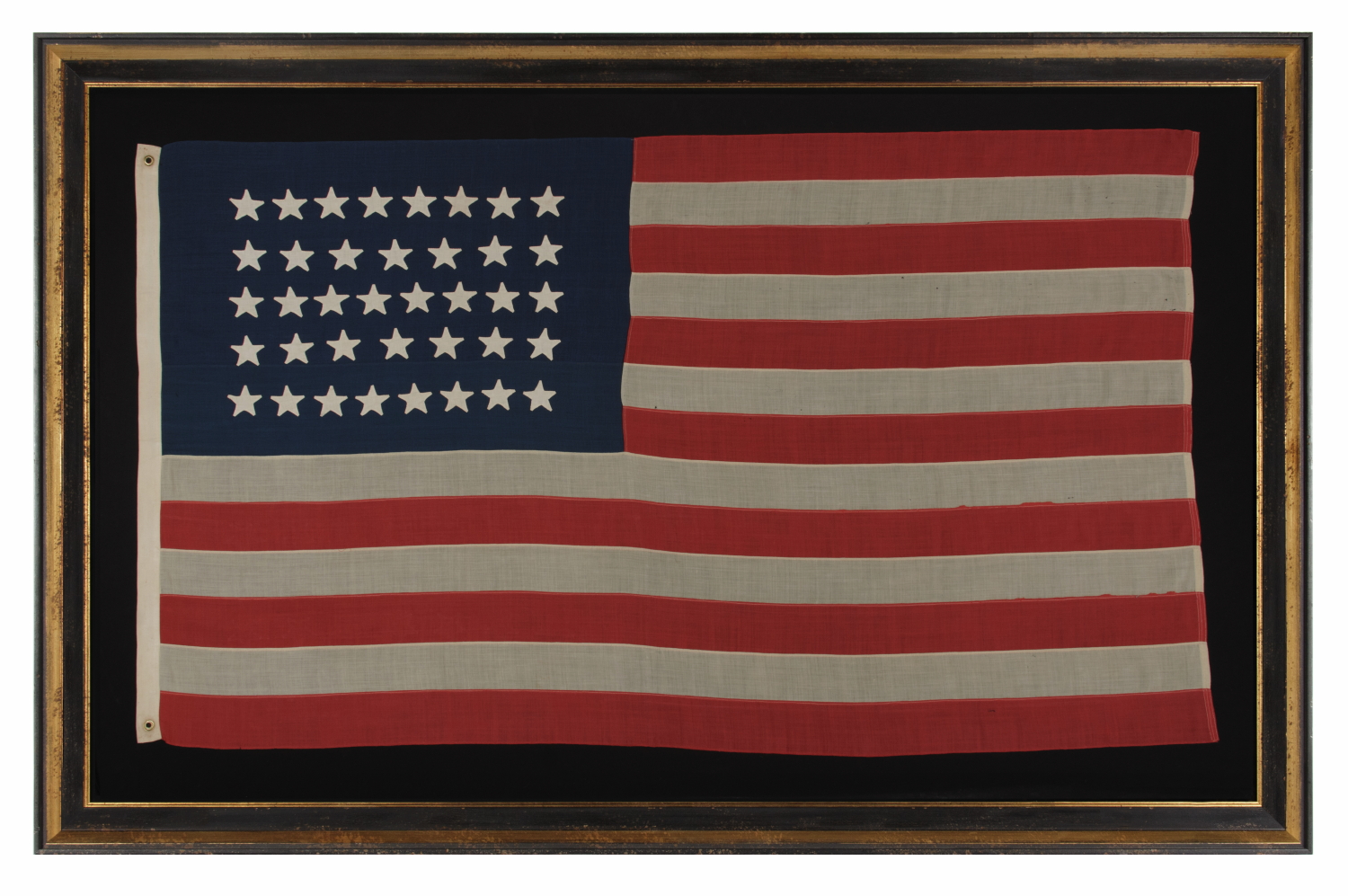
| |
38 STAR FLAG WITH HAND-SEWN STARS, IN AN UNUSUALLY CONFINED PATTERN OF JUSTIFIED ROWS, ON AN ANTIQUE AMERICAN FLAG IN A SMALL SCALE FOR THE PERIOD, 1876-1889, COLORADO STATEHOOD |
|
| Available: |
Sold |
| Frame Size (H x L): |
Approx. 59" x 96" |
| Flag Size (H x L): |
47.25" x 84" |
|
| Description....: |
|
38 star American national flag in a bold yet manageable size among its 19th century counterparts having pieced-and-sewn construction. The stars are made of cotton, hand-sewn, and double-appliqued (applied to both sides). These are arranged in justified lineal rows in counts of 8-7-8-7-8. All of the stars are oriented in an upright position (with one point up), but what's unusual about them is the amount of blue canton that surrounds them. Note how the stars are corralled in a tight regiment within the center of the union. Also note that their tips are slightly flattened, which lends an attractive appearance.
The stripes and canton of the flag are made of wool bunting that has been pieced with treadle stitching, which is typical of the period. There is twill cotton binding along the hoist with two brass grommets.
Colorado became the 38th state on August 1st, 1876. This was the year of our nation’s 100-year anniversary of independence. Although 37 was the official star count for the American flag in 1876, flag-making was a competitive venture and no one wanted to be making 37 star flags when others were making 38’s. It is for this reason that 38 and 13 stars (to represent the original 13 colonies) are more often seen at the Centennial International Exposition, the six-month long World’s Fair held in Philadelphia in honor of the event. Many makers of printed parade flags were at the same time producing 39 star flags, in hopeful anticipation of the addition of another Western Territory. The 38 star flag became official in 1877 and was generally used until the addition of the Dakotas in 1889.
During the 19th century, flags with pieced-and-sewn construction (as opposed to printed) were typically eight feet long or larger. This is because they were important in their function as signals, meaning that they needed to be seen and recognized from a great distance. Even flags made for decorative purpose were generally very large by today’s standards. A small flag was six feet in length and this particular example measures just over that on the fly. Smaller flags were even more unusual. Since the average 19th century sewn flag can be cumbersome to frame and display in an indoor setting, many collectors prefer printed parade flags and smaller sewn flags, like this one, the size of which provides a good balance between visual impact and versatility.
Mounting: The flag was stitched to 100% silk organza on every seam and throughout the star field for support. It was then sewn to a background of 100% cotton twill, black in color, which was washed to remove excess dye. An acid-free agent was added to the wash to further set the dye and the fabric was heat-treated for the same purpose. Fabric of similar coloration was placed behind the flag during the mounting process, both for masking purposes and to strengthen the flag against the dark ground. The mount was then placed in a black-painted, hand-gilded and distressed Italian molding. The glazing is U.V. protective Plexiglas.
Condition: There is extremely minor mothing in very limited areas. Parts of the top seam along the 5th and 6th red stripes, toward the fly end, are partly untucked. The overall condition is absolutely extraordinary. This is the very best condition that one may encounter in this period in a flag of this construction and scale. |
|
|
|
| Collector Level: |
Intermediate-Level Collectors and Special Gifts |
|
| Flag Type: |
Sewn flag |
|
| Star Count: |
38 |
|
| Earliest Date of Origin: |
1876 |
|
| Latest Date of Origin: |
1889 |
|
| State/Affiliation: |
Colorado |
|
| War Association: |
1866-1890 Indian Wars |
|
| Price: |
SOLD |
|
| |
Views: 3082 |
|
|
|

